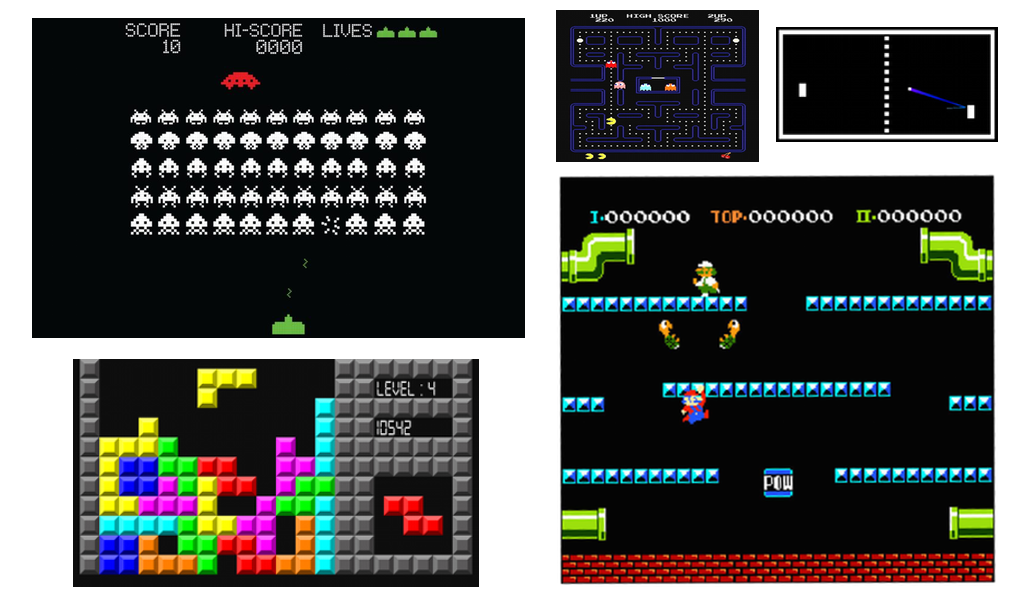
Are you having trouble coming up with new game ideas?
If your mind is going blank and no matter how hard you try nothing seems to come to you. Don’t worry. We’ve all been there. The truth is … being creative and coming up with game ideas is a skill that you have to hone, not a talent. Anyone can become a master at generating awesome game ideas if they apply and practice the right methods.
Although, there are dozens of different techniques that will help you unleash your creativity. We compiled a list designed specifically with game developers in mind. Each of these 19 methods will help you get those creative juices flowing again and make it easy for you to come up with a killer game idea.
Here’s how:
#1 – Play a Lot of Games
Games have the ability to transport us into a different world, entertain, and challenge us in new exciting ways. When you’re trying to come up with your own unique game idea, they’re also one of the best ways to find inspiration. It’s really important to try to play a lot of different style games, not just your personal favorites. Try to start with the classics and work your way up to the Indies and then some of the more popular newer titles. Games like Space Invaders, Tetris, Mario Bros and others is a good place to start, especially if you haven’t played many of them before.
Believe it or not, most of the games that we consider to be classics were created by individuals or small development teams. Also, many of the classics are simple style games that feature dynamic gameplay with tons of replay value. All of which are the secret ingredients to a successful game. Revisiting them can help get those wheels turning again. Notable indie games like Limbo and Monument Valley are great to play and study as well. Try to find a few of the top current games in different categories to play also.
When you’re playing, pay close attention to all of the little details that make the game fun and unique. Grab a small notebook and jot down any features, themes, color schemes, characters, effects or gameplay mechanics that stand out to you.
#2 – Be Observant of the World
As Steve Jobs once said, “Creativity is just connecting things. When you ask creative people how they did something, they feel a little guilty because they didn’t really do it, they just saw something. It seemed obvious to them after a while.”
To be creative and come up with game ideas you have to be able to connect things. And to connect things you need to be observant. Start paying attention to all the little details. Notice your environment, people, and all the small things that we often overlook. The tree tops, the clouds rolling by, clothes tumbling in the dryer, virtually anything can be used as inspiration when you’re fully aware. You never know what might spark an idea for a new theme, background or interesting gameplay concept.
Try to pay attention to everything around you and come up with ways you could implement them into your game. Ask yourself, “Could this be used in a game?” If so, ‘How?’ Write it all down. The answers might surprise you. You’ll also find that your creativity level will spike as you continue to practice being observant. Ideas can spring from the strangest places.
#3 – Seek Input
As the wise saying goes, ‘When in doubt, ask.’ Always seek out input from others when you’re trying to come up with game ideas. Ask around. Try to start up a ‘game related’ conversation and sneak in some possible game concepts that you’ve been bouncing around in your head. Be inquisitive and find out what type of games people like to play by asking your friends, co-workers, family members or even strangers on the street. The more opinions, the better. If it’s a concept you’ve been thinking about but not quite sure, ask people what they think of it. Remember, you don’t have to tell everyone you’re working on a game when you do this. If you’re afraid of someone possibly stealing your idea, you can be vague with your question and still gain valuable feedback. Asking around will help you get a good idea of which direction you could go with your game.
#4 – Use an Idea Log
Everything begins with an idea. So it’s important to keep track of them. Use a small notepad or an app on your phone to record any ideas that pop into your head. Using a game idea log can make it easier to come up with ideas. Before you know it, you’ll have an entire little book of potential hit games.
The key is finding a method that suits you best, that you’ll be able to keep up. If you like the nostalgia of pen and paper, invest in several small pocket size notepads and keep one with you wherever you go. If the paper method isn’t your style, you can use the note app on your phone to create a game idea log or download one of the many notebook based apps that they have available. Whichever method you choose, remember it must be easily accessible.
You never know when a random idea will hit. When you have a system down for capturing great ideas, you’ll never be without one.
#5 – Mind Map It
Mind mapping is a visual method of brainstorming where you use words, images, and colors to connect ideas around a specific topic. Using this technique, you can quickly generate lots of different game ideas. It’s also a fun way to organize creative ideas.
To start mind mapping a potential game idea, you’ll need a piece of paper, pen, and some colored pens or markers. Choose your game type (i.e. arcade, platformer, puzzle, action) and write it down in the center of the piece of paper and circle it. Then begin to write down main ideas using one word and ‘connect’ by drawing a line from the circled word to your centered game type. These ideas can be a theme, feature, background element, game mechanic, character, effect or any other detail. Try to write and circle each idea in a different color. You can even doodle or draw out the idea if you wish. It’s your mind map. Go through each, brainstorming and breaking down those ideas until you have a big beautiful, creative map of your next game concept.
Mind mapping allows you to connect ideas and figure out what’s missing more quickly. In fact, the brain works better creatively with non-linear techniques like mind-mapping.
Okay, I know what you’re thinking … but what if I don’t want to sit with colored pens mapping? Well then, don’t. There’s mind mapping software that you can invest in. The software allows you to create a mind map quickly on your computer. And there are also dozens of apps like Mind Vector, Mindly, MindMeister and iMindQ that you can download for free on your phone to mind map on-the-go. The apps are a cool option. Many of them utilize the Cloud and can be saved and accessed later from anywhere. You can also collaborate with friends or teammates which are great if you’re working with someone else or a small team.
#6 – Research
To come up with a great game idea, you need to know what’s already working. Research is a necessity, especially if you’re trying to come up with winning ideas. It’s important to research which games are topping the charts, in which categories, and why, so you don’t end up wasting your time on a concept that no one is going to like or play. Researching the charts and current trends will give you a slight advantage and make it easier to brainstorm new ideas.
To research just browse the top charts in the App Store. Look at all of the high ranking games in the same category that you want to make your game in. Pay close attention to the games that appear to be from indie developers and write them down. Then thoroughly research each game. Google to find out more information about the games. Then download and play each game. Analyze the game’s features and jot down any element that stands out. Examine your notes and use them as starting points to base your game idea on.
#7 – Get Active in the Gaming Community
Being active in the gaming community is another way to spark creativity and generate game ideas. When you’re involved in the game scene, ideas automatically come more easily to you. So get involved! Become active in the gaming community. You have to do more than just play a bunch of games to do this. To be involved you need to join and actively participate on the forums. Browse different message boards and read what other gamers and developers are discussing. Post and ask questions. Get curious. The gaming community is an untapped resource that developers need to take advantage of. You can find inspiration, learn tips, and get guidance, network, and gain lots of useful feedback from gamers and peers.
#8 – Model & Improve
We believe strongly in the ‘Model and Improve’ method, here at Buildbox. It’s the secret technique that many successful developers and entrepreneurs use to come up with killer ideas. When you model and improve, you’re taking a concept, breaking it down and finding new ways to make it better. By adding something extra to it, modifying it or combining it with other elements you end up creating an entirely new version that’s unique. For game ideas, simply research to find popular games in the niche you’re interested in and then analyze them. Once you’ve broken down the game’s features and key elements, brainstorm different ways to improve on each feature. Ideas will quickly start to flow.
#9 – SCAMPER Method
David Reichelt created his hit game Color Switch (which to-date has amassed over 150M downloads) using our software, Buildbox. When asked in an interview, about his process for coming up with game ideas, Reichelt credited the SCAMPER method from the Michael Michalko book called Thinkertoys. The SCAMPER method is basically ‘model and improve’ on steroids. Instead of simply brainstorming ways to improve on a concept you apply nine specific techniques to help you reinvent the concept. Each letter in the acronym represents one or more idea triggering questions that you need to ask yourself.
To use the SCAMPER technique you have to analyze an idea and ask yourself if you can substitute, combine, add, modify, magnify, put to other use, eliminate, reverse or rearrange it. It’s an innovative way to get creative and brainstorm new game ideas.
#10 – Focus on a Genre
If you’re having trouble coming up with game ideas, focusing on a specific game category or genre can help. The more specific you are, the easier it is to generate ideas. Try to pick a game genre that you’re interested in and begin to brainstorm ideas only in that category. Whether its arcade, action, puzzle, racing, shooter, adventure or strategy, try to focus only on that particular genre. When you’re brainstorming game ideas, look at other similar games in that category and search for ways to model and improve.
#11 – Pick a Theme to Explore
Sometimes you need to go even further and when you’re thinking up game ideas and pick a specific theme to explore as well. Selecting a particular genre and theme will help you better pinpoint the type of game you want to create. A few minor details can make a huge difference in the overall shape of your game. For example, a simple shooter style game with a space theme is now much more interesting. Adding that one extra touch can ignite your imagination. As you think more about the concept, you’ll be able to come up with more elements to add and pretty soon you’ll have a great game idea in the works.
#12 – Start-Off with a Character
Starting off with a character in mind is another method that’s worth trying if you’re stuck in the middle of a creativity block. When you select the main character first, it can make the process of coming up with a game idea much easier. You can simply brainstorm around that one core element until you have a complete concept. Your main character can be a person, creature, object or a particular place. Once you have a set character, try to think up different possible scenarios that could work. Consider how your character would interact and respond. Brainstorm alternative themes, challenges, and gameplay based around your main character.
#13 – Schedule a Brainstorm Session
Don’t drive yourself crazy trying to think up ideas. Avoid sitting for hours on end, waiting for something to come to you. You’ll burnout quickly if you do. Instead, try to break up your brainstorming sessions into manageable blocks. Pick a time of day that works best for you. Everyone is different. Some people get their best ideas early in the morning, enjoying a cup of coffee, while others prefer to burn the midnight oil. When you schedule a brainstorming session, it’s important to pick a quiet place where you can think. Set your timer for 15 to 30 minutes and then start brainstorming potential game ideas. When the timer goes off, stop. Continue to go about your day or do some other activity until your next brainstorming session. Depending on your schedule and time restraints you can do one or multiple sessions throughout the day until you’ve come up with something great.
#14 – Use Constraints
Constraints or limitations help to encourage creative thinking. If you need to come up with some unique game ideas than adding constraints is the way to go. They’ll help you narrow down your options and focus your creativity. Try to use constraints like theme, time, tools and skill to brainstorm your concept.
Start by selecting one specific theme that your idea must be based on. Give yourself a deadline to complete your game. When you know, the amount of time you have available is limited you’ll have to think up game concepts that are doable within those set limits. This will keep you from thinking in the mind frame of ‘unlimited possibilities’ which often is what leads us towards a creativity block. Constraints help to keep your design concept realistic which is important to do.
Tools and your current skill level are also restrictions you need to consider when you’re coming up with game ideas. What type of game can you make? Which tools do you need to help you accomplish your goal? What is your budget? Knowing and working within your limitations will lead you towards success. Turn your restrictions into an advantage by using them to fuel your creativity.
#15 – Draw Inspirations from other Mediums
Games are not the only type of media that you can draw inspiration from. You can also draw inspirations from other mediums like film, TV, art, music and books. What are your favorites? What is it about them that speaks to you? Search for elements in other mediums that could be used as a base for a game idea. It could be anything. Maybe a cool concept or action scene from a movie or show, a beautiful piece of art, a great song or the song’s album cover. Inspiration is everywhere when you’re looking for it.
#16 – Take a Break
Sometimes the best way to come up with ideas is to take a break from coming up with ideas. It sounds counterintuitive, but it works. Stepping back from the process and doing something else will allow you not only relax but to avoid burnout as well. Whenever you’re at the point where you’re beginning to get frustrated, take 20 minutes, an hour or even a day and break away. Take a long shower or power nap if you need one. Go for a walk in the park. Play your favorite game or listen to some music. Do whatever you like to do to unwind. Then when you’re ready to come back to it, you can look at it with fresh eyes.
#17 – Use a Game Idea Generator
When you need a little help coming up with game ideas, generators are also an option. Now, we don’t recommend using them literally. Some of the results can be outlandish, but they’re great tools to use to spark your creativity. Simply take the random idea and tweak it to a realistic concept. You can also play around with it and pull different elements from each idea generated to come up with a cool idea. Game idea generators are fun tools to use to help bust through a game creation block. Two good game idea generators to try is Orteil’s Game Idea Generator and Streaming Colour’s Game Idea Generator.
#18 – Read the Latest News & Reviews
Reading the latest industry news and game reviews can also help generate game ideas. Online publications like Gamasutra, PGBiz, Polygon, IGN, 148Apps, Touch Arcade, and Indiegames.com are all excellent sources to help keep you in the know. When you have a good idea of what players like and what they don’t like, you’ll be able to come up with game ideas more quickly. Try to make reading and staying up on the latest trends a habit. To keep track of your game news, download an RSS feed reader app like Feedly or Pocket. You can also add any interesting game development blogs to your RSS feed as well. The more embedded you are in the game scene, the better.
#19 – Just Start & Game Ideas will Flow
If you’re having trouble coming up with game ideas, sometimes it helps just to start creating something. It’s easy to get overwhelmed with your own expectations on what you should be making. Diving right in and making a ‘practice’ game can alleviate a lot of the self-imposed pressure and unleash your creativity. When you’re not worried about making a perfect game, and you’re just messing around, your wheels will start turning, and ideas will come to you as you go. Just pick a random game type and run with it. You might just end up with the perfect game, by accident. You never know.
When you feel stuck, try one or all of the great tips mentioned above. Remember, making games, in general, should be a fun process. If you’re struggling to come up game ideas, take a deep breath, breathe out and relax. Play a ton of games, be observant, try different methods of brainstorming, research, work within your limitations and remember that ideas will come to you as you go.
Remember, creativity is just about connecting things and being more open and aware.








there’s a broken image icon at mind-mapping area
Hey Tiana, what a great article! This was immensely helpful!!!
[…] can use the current game trends that you discovered as a springboard for coming up with killer game ideas. The best way to do this is by applying the ‘model and improve’ technique. This simple method […]
[…] we’ll talk about the best ways to come up with game ideas as an indie developer. We’ll also show you how to apply these strategies to help you overcome the […]
[…] game development forums and get their feedback as well. Talk about your game. Brainstorm different game ideas and ask others for their […]
mind blowing stuff with common basic concept which will ignore normally while search game ideas……thanks a lot.
[…] you become in the game development community, the easier it will be for you to come up with killer game ideas and start crushing it in the App […]
[…] you’re having trouble coming up with a game idea, try to study some of the top games in the App Store or on the specific platform that you’ll be […]
Great Tips! I’ll try using some of your tips for when I make my next game.
[…] and improve’ method when you’re brainstorming game concepts will help you come up with great game ideas. Research the top trending games in your selected category or genre and study all of the games from […]
[…] indie games is a great way to find inspiration to help you come up with new game ideas. As a developer, the more involved you are in the indie game scene, the easier it is to get […]
Another AAA article. Great writing Tiana. Thanks for putting it out there 🙂
Nice, thanks for the ideas.
Thanks, glad it helped :)
thank you so much Tiana you are the best
Tiana, Awesome Stuff.
nice writeup, thanks
some small corrections:
– “game scene ideas, automatically” – misplaced comma
– “which often what” – missing “is”
– url for Streaming Colour’s Game idea generator is missing in the text http://www.streamingcolour.com/blog/game-idea-generator/
Thanks George!
Thanks for all the excellent resources!
Thanks Franklin :)
Thank you so much. just reading your Blog gave me Inspiration.
Tiana You are the BEST
That’s awesome :) Yahia. Thanks so much!